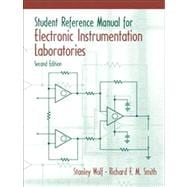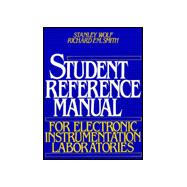Student Reference Manual for Electronic Instrumentation Laboratories

Student Reference Manual for Electronic Instrumentation Laboratories
- ISBN 13:
9780130421821
- ISBN 10:
0130421820
- Edition: 2nd
- Format: Paperback
- Copyright: 07/31/2019
- Publisher: Pearson
Note: Supplemental materials are not guaranteed with Rental or Used book purchases.
Extend or Purchase Your Rental at Any Time
Need to keep your rental past your due date? At any time before your due date you can extend or purchase your rental through your account.
Summary
The purpose of this book is to assist engineering students in finding information on both the theoretical and practical aspects of good laboratory practice. Most engineering textbooks omit the coverage of the practical information necessary to instrument, measure, and analyze data obtained during an experiment. With additional material being continually crammed into the curriculum, other material must be deleted. Since theoretical concepts are more fundamental and less ephemeral then technology-based topics, the latter is being de-emphasized in both the course syllabus and textbook.
Technology in the laboratory is rapidly changing to automatic measurements and data collection through the use of computers and other digital technology. Computers are continuing to increase in speed and capabilities, allowing much wider bandwidths in measuring dynamic signals. To meet the demands placed on students to collect more data and perform sophisticated analysis on it, in this latest revision many of the older analog instruments have been deleted and replaced by the latest digital instruments. There are still many applications where analog measurements are superior to digital. It has been a judgment call concerning which analog procedures to retain.
This manual is designed to be used alone or in conjunction with a laboratory course. Using this manual will allow the instructor to concentrate more on objectives and principles than on laboratory procedures, data analysis, and operation of the equipment. Problems have been included at the end of each chapter so the student can practice some of the principles presented.
The breadth of this manual permits students to purchase only a single text that will serve as their reference for most engineering laboratory courses. In an endeavor to provide the manual at minimum cost, a soft-cover format was chosen for its production.
The overall objective of the book is to teach students to become proficient users of electronic measuring instruments and gain a practical understanding of electrical laboratory practices. In this regard, the book explains how to select instruments for various measurement applications, how to evaluate their capabilities, how to connect them together, and how to operate them properly. In addition, descriptions of the terminology, apparatus, and measurement techniques unique to the engineering laboratory environment are provided. In summary, the manual is meant to serve as a self-contained vehicle to carry the reader through most measurement tasks. References at the end of each chapter were selected to facilitate the student's ability to obtain more information on relevant information.
Our presentation is at a basic level—theory precedes laboratory work. With this approach, we can afford the luxury of developing the material in ample detail. Furthermore, many important subjects that tend to be overlooked in more advanced texts can be covered. For example, we place considerable emphasis on the discussion of concepts that are usually regarded by instrumentation experts as self-evident (e.g., grounds and grounding, electrical safety, ground loops, and impedance matching). Such concepts often remain as puzzles to the beginner unless they are explicitly explained.
Several chapters are allotted to a description of the most common components and quantities encountered in laboratory work. These chapters present practical information dealing with the construction, appearance, and uses of such items as resistors, capacitors, inductors, transformers, relays, batteries, power supplies, cables, switches, connectors, fuses, transducers, and amplifiers. Most students are totally unaware of the many variations of components and their specifications.
Digital measurements language is introduced in Chapters 1. Chapters 5, in its entirety, is allocated to digital meters, analog-to-digital conversion methods. Aspects of data communications between digital instruments and computers are carefully explored in Chapters 18. The discussion includes a basic but thorough introduction to the three predominant standards for communication between instruments and computers: the serial-asynchronous communication link with ASCII formatted data (RS-232 standard), the IEEE-488 standard bus, and the universal serial bus (USB).
Chapter 7 is a new chapter dedicated to the introduction of virtual instrumentation (VI) using LabVIEW which was developed by National Instruments. This chapter was compiled and edited by Darren Halla, of National Instruments in Austin, Texas. He was assisted by Academic Content Manager, Tamara Waite who assembled and edited the many graphics in the chapter. This chapter introduces virtual instrumentation and its application to computer-based data acquisition and control. Students can use the enclosed student version of LabVIEW to perform both real and simulated data acquisition and control, depending upon the hardware available to the student. There are numerous exercises and examples on the CD. The range of exercises is limited only by the imagination and ability of the student. Advanced applications are contained on the National Instruments Web site, www.ni.com, and many others can be found in the references at the end of the chapter.
In recognition of the trend toward greater use of instrumentation systems, the chapters in the latter part of the book (Chapters 14-18) are organized as a group that examines topics relevant to measurement system implementation and use. Electrical transducers, the sources of the signals in many systems, are dealt with in Chapters 14. Chapters 15 covers electronic amplifiers and their use in measurement applications. Chapters 16 deals entirely with electrical interference signals and their suppression. Sources of both internal and external noise are considered. A careful discussion of ground-loop and common-mode interference, along with techniques available to minimize their effects, is presented.
Chapter 17 explores various instrumentation system configurations as well as interfacing considerations in analog and analog-to-digital systems. Included are such topics as analog signal conditioning, analog signal transmission, multiplexers, and sample-and-hold circuits.
Thanks to the many students at Cal Poly Pomona University who contributed both problems and comments. We thank the reviewers who provided valuable suggestions and comments that were important in the final draft of the revision.
We especially thank our wives, Carol Ann Wolf and Donna Rae Smith and our families for their continued support and encouragement in this project.
A NOTE TO THE STUDENT
This book has been designed to provide you with a great deal of important, practical information on electronic instruments and electronic measurement techniques generally not covered in the formal lecture portions of the engineering courses you take. It is, however, information assumed to be part of the knowledge that engineering students acquire while pursing their degree. Ironically, our book is one of the few places where much of this kind of information is assembled in one place.
In the event that you are asked to study the material in the text without the benefit of an instructor's guidance, we have tried to present the material in as easy and a straightforward a manner as possible. The material should be readily understandable if you have completed the basic college physics sequence and a course in electric circuits.
As you move to more advanced laboratory courses (or even after graduation), you will appreciate being able to refer back to sections on specific instrument operating instructions (e.g., the oscilloscope, the curve tracer, the power supply, or the VOM) to help connect test setups and to make valid measurements. The sections dealing with the characteri







